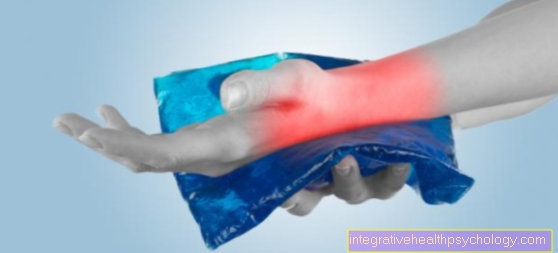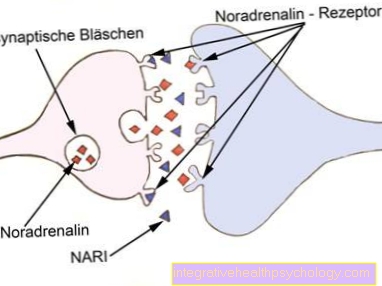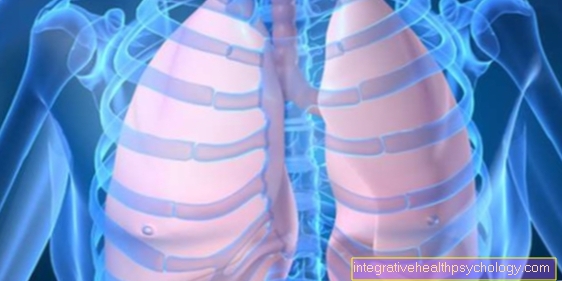Allergy to bee venom
introduction
An allergy is a reaction of the body's own immune system to foreign substances (so-called allergens) which actually do not have any infectious properties.
The organism reacts to these allergens by stimulating the development of inflammatory processes and the formation of antibodies. Most allergic reactions are manifested by rashes on the skin and / or mucous membranes. Bee venom (Apitoxin) is one of the typical substances that cause allergic reactions. It consists of a mixture of different secretions introduced into the skin by the bee sting (injected) become. For allergy sufferers, a bee sting is a life-threatening situation that must be treated quickly.
Read about this too Allergic reaction

Symptoms
In humans, the bee venom often causes small inflammations in the area of the puncture site. This inflammation is usually accompanied by local swelling, pain, and redness.
For the common non-allergy sufferer, a single bee sting does not pose any danger, for such people a multitude of stings can cause problems. For non-allergy sufferers, the only dangerous thing is bee stings in the neck and throat area, as the local swellings can severely narrow the airways and thus restrict breathing. In addition, it can lead to impairment of the respiratory tract, the eyes and the gastrointestinal tract. Many allergens also typically trigger fever, fatigue and severe sleep disorders.
For people who suffer from an allergy to the bee venom, however, a single insect bite far from the throat and throat area can be a life-threatening situation. Especially the shortness of breath is very pronounced here.
Also read our topics:
- Anaphylactic shock
- Allergy emergency kit
Causes of a bee venom allergy
As soon as the substances (allergens) contained in the bee venom get into the bloodstream, an allergic reaction can be triggered.
Every insect venom is composed of a different combination of substances, the bee venom contains among other things:
- Phospholipase A
- Mellitin and
- Hyaluronidase.
These substances play a key role in triggering an allergy.
As soon as the organism comes into contact with these substances via the bloodstream, it begins to produce certain defensive substances (so-called antibodies). In the course of the first bite, a large number of antibodies of the IgE (immunoglobulin E) class are produced and released into the bloodstream.
These antibodies then bind permanently to so-called mast cells, which in turn are counted among the white blood cells (leukocytes).
With every further sting that leads to the organism being exposed to the bee venom, the antibodies already formed recognize the allergens and form a firm bond with them (complex formation).
This is the signal for the entire organism to produce a certain substance, histamine, and to release it into the bloodstream.
Histamine, in turn, plays a decisive role in the development of the typical symptoms of an allergic reaction; it causes severe itching, pain and the contraction of smooth muscle cells.
This contraction, for example, significantly narrows the airways, which can lead to shortness of breath and, in the worst case, death from suffocation.
therapy
The treatment of an allergy to bee venom is divided into several sections.
On the one hand, the purely symptomatic treatment is of the utmost importance; on the other hand, certain preventive measures (Prophylactic measures) must be taken to prevent the occurrence of such an allergic reaction from the bee venom.
To avoid symptoms of allergy to bee venom (Itching, rash, airway swelling) so-called antiallergetics are used. This group of drugs can be administered in different forms. There are various ointments and creams, drops, tablets and nasal sprays available to help reduce the effects of allergen exposure.
Probably the most important point in an effective therapy is the prevention of an allergic attack (prophylaxis).
Measures should therefore be taken which either avoid the development of an allergy from the outset or which should prevent the body from reacting too strongly to the allergen. The preventive measures are divided into a primary and a secondary prophylaxis.
- Therapy for an allergy
- These drugs help if you have an allergy
Primary prophylaxis against bee venom
The term "primary prophylaxis" means those measures which ensure that the organism does not even develop an allergy to a foreign substance.
Avoiding allergen contact is currently the best and most effective means of primary prophylaxis. However, since complete avoidance of contact with allergenic substances is hardly feasible, one is content with avoiding certain situations and foreign substances.
In addition, various studies have shown that children who were breastfed for at least the first four months of life have a significantly lower susceptibility to developing an allergy.
You may also be interested in this topic: Allergy diagnostics
Secondary prophylaxis against bee venom
"Secondary prophylaxis" includes all measures that are used to prevent the occurrence of typical allergy symptoms or to greatly reduce the signs of an allergic reaction.
Avoiding allergen contact (allergen avoidance) is also of crucial importance here. This is particularly important because multiple contact with an allergenic foreign substance increases the concentration of antibodies of the IgE class and the immune response is correspondingly more violent with each subsequent contact.
Also read: Allergy pass
Specific immunotherapy (desensitization)
In the so-called desensitization (make it less sensitive) against bee venom, the patient is exposed to different high doses of the allergy-causing foreign substance (here bee venom) over a longer period of time. In many cases, the treating doctor does not use the actual bee venom allergen, but a foreign substance similar to the allergen, but modified (allergoid).
This allergoid can be injected directly under the skin or applied to the mucous membrane in the form of drops. In the long term, desensitization to bee venom prevents the immune system from reacting too much to the actual allergen.
Further information is available from: Desensitization





























